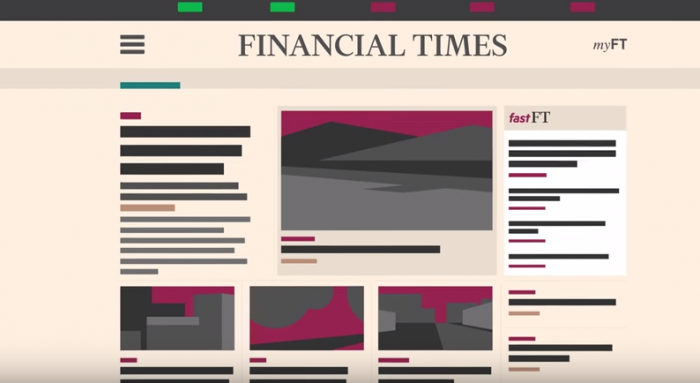
Financial Times readers will notice a redesigned FT.com on Tuesday, with many more customizable bells and whistles. Or else they may have already tried out the redesigned site, because the FT has been testing and tweaking it in the open, gradually rolling out the new version to readers over the past year (who could still toggle back to the old site).
The site overhaul was aimed at improving several key areas, all of which the FT hopes ultimately will lead to more paying subscribers: cutting down page load time, increasing engagement on the site, and adding more options for personalizing the reading experience. The new site loads in around 1.5 seconds on desktop and 2.1 seconds on mobile, “making it one of the fastest news sites amongst competitors,” according to chief product and information officer Cait O’Riordan. Page load speed and engagement are critically linked.
“We’ve run tests. If you can make the site a second faster, you can drive engagement by 5 percent,” O’Riordan said. “And we know that engagement is the key thing that drives everything else. It drives whether someone will take out a trial subscription, it determines how many adverts they see. So much of our revenue is driven by how engaged people are.”
The streamlining process was driven by user experience. As O’Riordan explained to me:
First of all we had a dedicated team, whose job was solely to make the site faster and to get that crucial page load working as quickly as possible. We gave them goals, based on user experience, not technical wins. The two things they looked at, when readers can start reading the page, and to make sure the reading wasn’t interrupted by the page jumping around. That helped focus and prioritize their work.
We were tough on the number of tags put on a page. It’s easy to get a lot of tags on the page that were designed really for measurement but end up really slowing things down, so we started with a blank slate. Instead of migrating all the tags from the old FT to the new one and then trying to reduce the number, we didn’t migrate any. And then any department that wanted to make a pitch for a tag to be added had to make a really strong pitch. We ended up with far fewer tags.
The key is there’s not one thing that will get your site faster.
Readers who used the new version of the site were “20 to 30 percent more engaged” (coming back more often, reading more stories), O’Riordan said. Because the FT was running the new and old sites in parallel, it was able to collect and compare engagement metrics between the two versions.
“We’ve been looking at different cohorts: our highly engaged users, but also users who come back less frequently, and looking at what use of the new website does to their engagement level,” O’Riordan said. “And we have really, really good data that use of the new site makes customers more engaged, including, crucially, people who were less engaged in the first place.”
The FT also ran surveys and user testing to collect qualitative data, from both subscribers and non-subscribers.
“The point of a public beta is you get really hard data on what people are actually doing, not just what they say they are doing,” O’Riordan said. “Then you roll in the personal feedback customers are giving on the site, and then you add in the face-to-face user testing, and it builds up a really strong picture of what’s working for us and what’s not working.”
The new site offers a myFT section for users to track topics they’re interested in, as well as revamped alerts and Markets Data and Portfolio tools. Users can now also “gift” articles, a feature that arose out of user feedback.“The feature now allows a subscriber to send an email to a colleague or friend or member of their family to allow them to read that article for free on the FT website. That was one we got really strongly from customer feedback,” O’Riordan said. “That wasn’t initially in the new version of the site. But people were telling us that was one of the features they really, really value.”